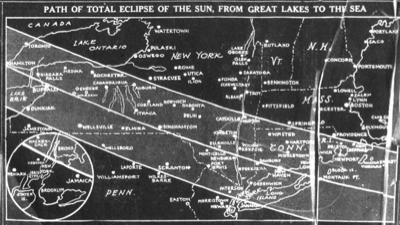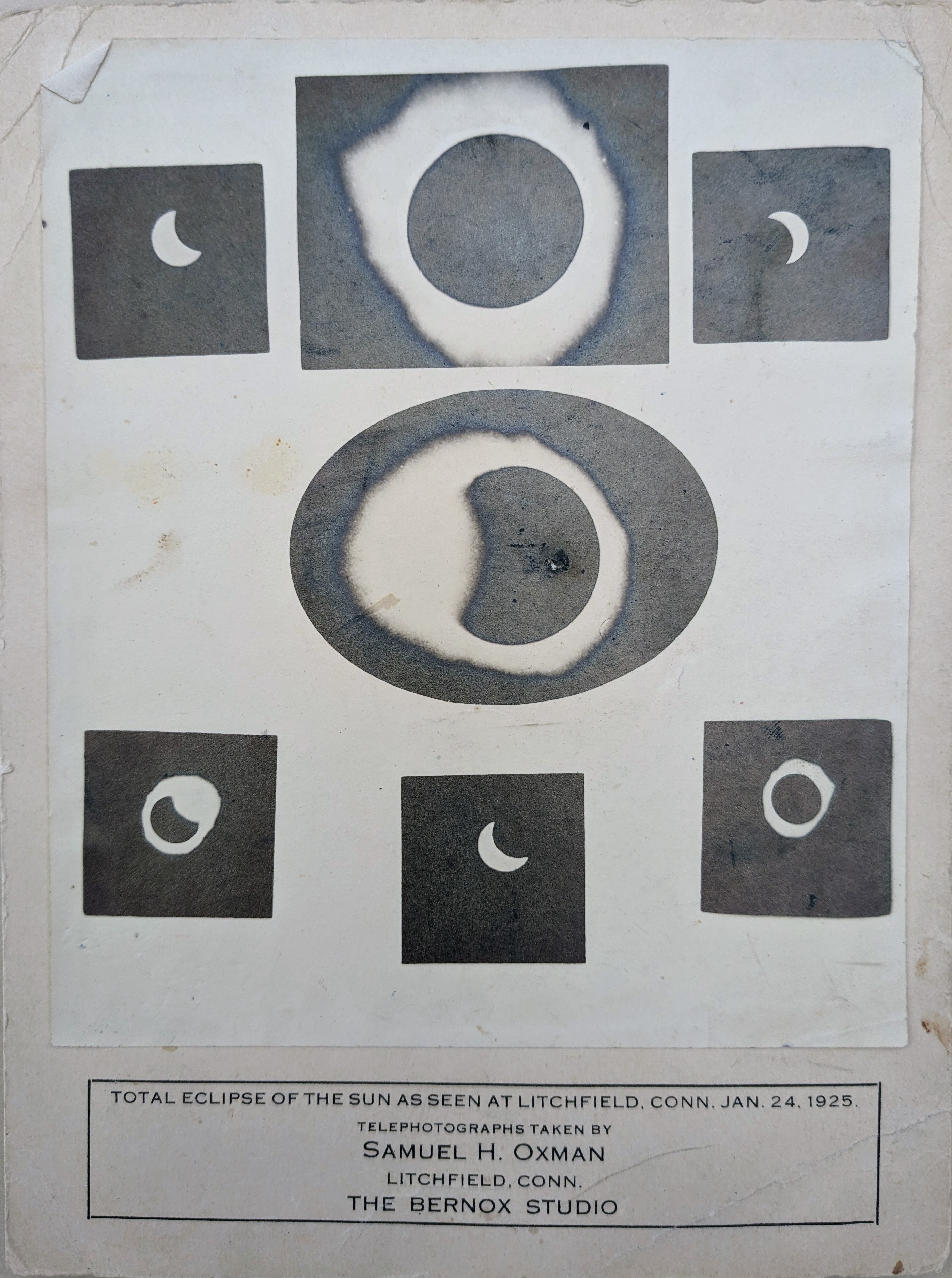Sweeping across the continent from Mexico through Canada on Monday, April 8, 2024 the “Great North American Eclipse” has captured the nation’s attention. NASA estimates that over 31 million people live in the path of totality and far more will travel to join them. Laying outside the path of totality for this eclipse, the people of Litchfield were plunged into mid-morning darkness on January 24, 1925.

Typed by part-time Litchfield resident Richard S. Chisholm, the account below details his anticipation of the event and the challenges amateur astronomers faced that snowy, cloudy January:
Total Solar Eclipse
January 24, 1925
As early as the spring of 1924 this event, scheduled for 9.11 A.M. at New York, was featured in the Astronomical journals and, owing to the centering of the path of totality near New Haven and its extension to Providence, R.I. northward and New York City to the south, created widespread and increasing popular interest as the day approached. Miss Annie Young, head of the Astronomical Department of Mt. Holyoke College and last year’s President of the AAVSO [American Association of Variable Star Observers], had issued for the use of her students the circular instructions for observing the eclipse which is attached and this was sent to all AAVSO members with the endorsement of the AAVSO Eclipse Committee. I had volunteered to join any expedition which might be sent out by the Association but either no expedition was organized or my enthusiasm was inadequate to compensate for lack of scientific knowledge, for I heard nothing further from Dr. Campbell. I therefore planned to go to Litchfield.
The 24th falling on Saturday I went to Litchfield the preceding Monday to reconnoiter for a good station from which to see the Sun between the hours of 8 to 1- A.M., which covered all phases of the eclipse. Tuesday at Litchfield produced a furious snow storm, which began during the night, so that no Sun was visible that morning, and there seemed a good prospect of my bring snowed in. There was nothing to do but head back for Katonah. The drive proved most difficult, the snow turning to sleet and rain and freezing to the windshield almost as fast as I could wipe it off with hot alcohol and water from the radiator. Wednesday and Thursday were cloudy in New York but late Thursday it cleared off cold, 24 hours too soon for a certainty of clear weather for Saturday. Friday was cold with NW wind. I started for Litchfield via Katonah at 11.14 A.M. and reached Litchfield about 6 P.M. The mercury in the house registered in the twenties and during the night fell to 8 below outside. I had been watching the weather feverishly all the week and was so excited Friday evening at the prospect of favorable conditions for the great event on the morrow that I could scarcely eat or sit still all the evening – the room was too cold for comfort anyhow even with felt boots and fur coat. I re-read all the literature on the eclipse that I had and tried to become so familiar with all the features of interest to look for that no time would be lost during those precious 110 seconds.

Up at six Saturday morning. The Sun rose at about 7.15 in a light bank of clouds and all of the sky was cloudy except a strip on the eastern horizon and to the south. The clouds seemed to be drifting towards the ecliptic. The outlook was most discouraging and I ruefully contemplated the prospect of missing the Eclipse at Litchfield while those in the clear zone to the south were enjoying the great experience. The partial phase was of course already in progress but I could see nothing of it, only the bright spot of the Sun behind the clouds. By 7.30 I was becoming desperate. There was still the chance, however, that I could speed southward into the clear sky, so I went for the car. The snow between the garage and the highway was so deep that I could not back out without shoveling it away. I worked furiously at this for half an hour and reached the state road at 8 o’clock. When I reached the “turn of the road” just beyond Mt. Tom Pond I came upon two cars headed in the opposite direction standing on the roadside and evidently awaiting the eclipse. Getting out and surveying the sky it appeared that the clouds were now drifting from the southeast, for the clear strip on the eastern horizon had widened, and that before 9 o’clock the ecliptic would be clear. So there I stayed. I had brought the apple grader with holes varying from 2” to 3” in diameter which I stuck in the snow at an angle to make its plane perpendicular to the line to the Sun for viewing the light crescents. A stop watch, opera glasses and dense photographic negatives completed my equipment. I was afraid to use the telescope because of its small field which would not cover the corona.
By 8.25 the clouds had left the face of the Sun and I got the first view of the partial phase. The Moon’s disk covered a little more than a third of the Sun, the Sun appearing as a thick crescent with one of the cusps a little to the right of the uppermost point and the other somewhat below the center of the right. The light diminished very gradually. I was intensely cold and seemed to be getting gradually colder. As the bright crescent diminished I watched for the double shadows, the light crescents and Baily’s Beads. I saw neither the double shadows nor the crescents and am not sure of the Baily’s Beads. The feature that struck me most forcibly about the disappearance of the bright crescent was its rapid shortening from both ends, becoming smaller in that way faster than it narrowed. How to describe the shadow bands? Faint at first an the bright snow of the roadside they rapidly increased in definiteness and rapidity. The effect was exhilarating, exciting. Their axis was in the direction of the Sun but whether they moved from NE to SW, or vice versa, before and after totality, I cannot say. Rather as it seemed to me, they oscillated and that was the impression produced upon the other people near me. There was, however, no mistaking the long, narrow, block-like form of the shadows, faint on the end towards the Sun and increasing in definiteness to the other extremity. Turning away from the Sun I looked in vain for the heralding onrushing shadow of the Moon and this was seen by no one with whom I talked in the vicinity of Litchfield.

Then suddenly the dusk of a clear Autumn sundown, the horizons darkest and of a rosy glow, the vault of the sky dark blue gradually brightening in the direction of the Sun, which, on turning around, I now found in total eclipse. The great size of the whole phenomenon, black moon, inner and outer Corona, was what at first struck me most forcibly. The inner Corona was of a brilliant silvery hue and extended in a circle from the sharp edge of the Moon, a distance of about 1/5 the Moon’s diameter. This in turn, while distinct from the outer Corona, blended into the outer Corona, which also of a silvery hue, but less brilliant, reach outward from the Moon for a distance of about the Moon’s diameter and faded away in streamers. No color of prominences were visible to the unaided eye or with the opera glasses. Upward and a little to the right shone Venus, Mercury and Jupiter clustered in an arc and in the order named, and of brightness in the order of Venus, Jupiter, Mercury. In the SW was Saturn somewhat dimmer that the other three. Just before the end of totality the Corona seemed to spread out to a much greater distance and colored as the rainbow, puzzling, but greatly enhancing the beauty of the scene. Then it appeared that to the passing of a filmy cloud refracting the Coronal light was due this unexpected phenomenon. The rainbow lasted for about ½ a minute after the end of totality. The duration of totality was about 1 minute and 50 seconds.
A burst of light at the upper right quadrant of the Moon’s black disk, again the excitement of the shadow bands, the planets paling, vanishing, and it is a still cold morning of a winter’s day with nothing unusual to be seen except with the aid of three or four thicknesses of dense photographic negatives.
After the best part of half an hour, hands having absorbed sufficient heat from the radiator for the return, the office stove completed the warming process and notes were recorded. Light clouds were drifting over the Sun but, the telescope having been set up on the front terrace, I looked from time to time for sunspots. None were visible. At about 10.30 I looked for the last time. There were no spots but a dark speck was just slipping off of the lower right hand limb (as inverted by the telescope) and I noted the tome of last contact at 10 hrs. 30 mins 50 secs A.M.
R.S. Chisolm